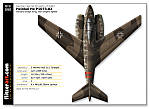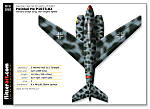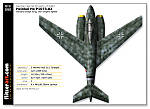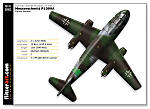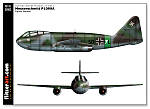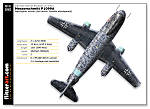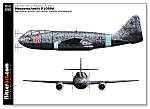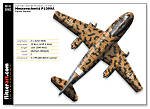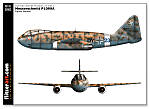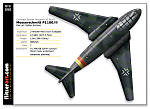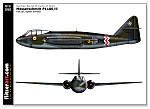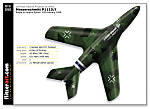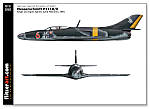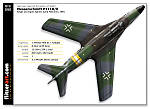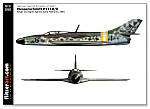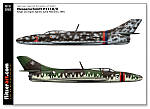German WW2 Secret Projects - Vol. 3
4
Comments
I have done another set of German secret projects to complete the hat-trick so to speak. And as with the previous two recent volumes, I have both re-visited some aircraft done previously and have produced some completely new ones.
However, I’d never seen this project version before, until Anatoliy Borovik of ‘Secret Projects.co.uk’ kindly sent me the basic 3-view drawing recently. The design incorporated a forward swept main wing and the two engines mounted one either side of the forward fuselage on very short pontoons which where angled slightly inwards at the intakes. There was also an indentation on the underside of the fuselage to house a single bomb.
There is no indication of where armament would have been housed, but I guess the solid nose would have been the ideal location.
A large number of detailed proposals were submitted in March 1944 encompassing a vast array of armament alternatives.
The first Messerschmitt Me P.1100 had a small canopy offset to the port side for the pilot, while the navigator/bomb-aimer was seated deep within the fuselage nose.
The more advanced P1110.02 again used the wings and tail from the Me262 but this time those of the HG development series. The wings were longer and much more swept at 45 degrees with the two He S011 A engines moved inboard, buried in the wing roots. Although no armaments were at initially catered for, as with the P1099, many armament combinations were proposed.
Both the P1099 and the first P1110 concepts were to use two Jumo 004C engines until they could be replaced by He S011 A jets once they became available. Eventually all work ceased on both projects in 1945 due to the RLM considering them underpowered.
Messerschmitt Me P1110/l
For the 1110 project Messerschmitt designers tried to package main fuselage components one behind the other, starting at the nose; armament, forward undercarriage, cockpit, fuel tanks and jet engine. This made for a very compact slim arrangement with a pencil like fuselage, but raised the question of where best to position the intakes to feed the jet engine.
For the P1110/I the engineers mounted a fan ahead of the engine to draw in air from a novel annular intake that surrounded the entire circumference of the fuselage ahead of the engine position. The design also had main wings based on the P1106, and a butterfly tail.
When submitted to the RLM it caused great interest but they erred on caution and questioned the annular intake arrangement.
Messerschmitt Me P1110/ll
In answer to the RLM comments about the first designs, Messerschmitt reworked the design which adopted a more conventional swept tail and wooden wings. The annular intakes were dropped in favour of intake scoops on the fuselage flanks. There were many variations mainly investigating the ideal shape and position for these.
These advanced looking designs would not look out of place even today in the inventory of most modern air forces.
In fact the SAAB Lansen, although twin engined and much larger, bears a remarkable similarity but no connection has been found or proved.
Next time The British.
Please note that all colours used in the profiles are standard RLM colours or derived from mixing them for shades and new colours that may have been evident due to the methods of application and the paint supply circumstances in the latter part of WW2.
The following references proved invaluable in helping me to produce these profiles.
Dan Johnson’s Luft 46 site: www.luft46.com
Luftwaffe Secret Projects: Fighters 1939-1945 by Walter Schick, Ingolf Meyer, Elke Weal, and John Weal
Luftwaffe Secret Projects: Strategic Bombers 1935-1945 by Dieter Herwig
Luftwaffe Secret Projects, Volume 3: Ground Attack & Special Purpose Aircraft by Dieter Herwig
Jet Planes of the Third Reich Vols 1 and 2 by Manfred Griel
Heinkel He P1073.02
There are many designs within the P1073 series including both twin and single engine designs. One in particular had a single jet engine mounted atop of the fuselage ‘piggy-back’ style and was developed in to the now familiar He 162 Salamander.However, I’d never seen this project version before, until Anatoliy Borovik of ‘Secret Projects.co.uk’ kindly sent me the basic 3-view drawing recently. The design incorporated a forward swept main wing and the two engines mounted one either side of the forward fuselage on very short pontoons which where angled slightly inwards at the intakes. There was also an indentation on the underside of the fuselage to house a single bomb.
There is no indication of where armament would have been housed, but I guess the solid nose would have been the ideal location.
Messerschmitt Me P1099A
With the aim of expanding and developing the Me262, Messerschmitt submitted this advanced proposal in January 1944, designed to utilize the wings and tail of the Me 262A-2a. The only modification was to move the engines aft a little for reasons of improving centre of gravity and balance. The biggest difference was a completely new fuselage enlarged to accommodate a crew of two and a much heavier undercarriage. Many variants were planned to take up heavy fighter, interceptor, zerstorer and night fighter roles to tackle the growing threat of allied bombers. The first design, the 1099A, illustrated here, saw much work by Messerschmitt which culminated in the heavy armament version, the 1099B.A large number of detailed proposals were submitted in March 1944 encompassing a vast array of armament alternatives.
Messerschmitt Me P1110.02
In answer to a requirement for a fast bomber, Messerschmitt produced the MeP1110 which bore a very similar resemblance to the P1099 series.The first Messerschmitt Me P.1100 had a small canopy offset to the port side for the pilot, while the navigator/bomb-aimer was seated deep within the fuselage nose.
The more advanced P1110.02 again used the wings and tail from the Me262 but this time those of the HG development series. The wings were longer and much more swept at 45 degrees with the two He S011 A engines moved inboard, buried in the wing roots. Although no armaments were at initially catered for, as with the P1099, many armament combinations were proposed.
Both the P1099 and the first P1110 concepts were to use two Jumo 004C engines until they could be replaced by He S011 A jets once they became available. Eventually all work ceased on both projects in 1945 due to the RLM considering them underpowered.
Messerschmitt Me P1110/l and P1110/ll
The P1110 series produced at least six designs and officially are identified by the date of the drawings, but in more recent times they tend to be split in to 3 groups. These being P1110/l, P1110/ll and a one off canard wing design, the P1110 Ente (Duck).Messerschmitt Me P1110/l
For the 1110 project Messerschmitt designers tried to package main fuselage components one behind the other, starting at the nose; armament, forward undercarriage, cockpit, fuel tanks and jet engine. This made for a very compact slim arrangement with a pencil like fuselage, but raised the question of where best to position the intakes to feed the jet engine.
For the P1110/I the engineers mounted a fan ahead of the engine to draw in air from a novel annular intake that surrounded the entire circumference of the fuselage ahead of the engine position. The design also had main wings based on the P1106, and a butterfly tail.
When submitted to the RLM it caused great interest but they erred on caution and questioned the annular intake arrangement.
Messerschmitt Me P1110/ll
In answer to the RLM comments about the first designs, Messerschmitt reworked the design which adopted a more conventional swept tail and wooden wings. The annular intakes were dropped in favour of intake scoops on the fuselage flanks. There were many variations mainly investigating the ideal shape and position for these.
These advanced looking designs would not look out of place even today in the inventory of most modern air forces.
In fact the SAAB Lansen, although twin engined and much larger, bears a remarkable similarity but no connection has been found or proved.
Next time The British.
Please note that all colours used in the profiles are standard RLM colours or derived from mixing them for shades and new colours that may have been evident due to the methods of application and the paint supply circumstances in the latter part of WW2.
The following references proved invaluable in helping me to produce these profiles.
Dan Johnson’s Luft 46 site: www.luft46.com
Luftwaffe Secret Projects: Fighters 1939-1945 by Walter Schick, Ingolf Meyer, Elke Weal, and John Weal
Luftwaffe Secret Projects: Strategic Bombers 1935-1945 by Dieter Herwig
Luftwaffe Secret Projects, Volume 3: Ground Attack & Special Purpose Aircraft by Dieter Herwig
Jet Planes of the Third Reich Vols 1 and 2 by Manfred Griel
Comments
Another set of excellent work from Peter. Lots of inspiration of all those Luftwaffe '46 kits out there.
Thanks for the time and effort put into these.
JUL 11, 2008 - 11:38 PM
I see my babies were left in capable hands.
Once again many thanks to Rowan and your kind comments.
British set now started
Cheers
Peter
JUL 23, 2008 - 12:05 AM
Copyright ©2021 by Peter Allen. Images also by copyright holder unless otherwise noted. The views and opinions expressed herein are solely the views and opinions of the authors and/or contributors to this Web site and do not necessarily represent the views and/or opinions of AeroScale, KitMaker Network, or Silver Star Enterrpises. Images also by copyright holder unless otherwise noted. Opinions expressed are those of the author(s) and not necessarily those of AeroScale. All rights reserved. Originally published on: 2008-07-12 00:00:00. Unique Reads: 38780





